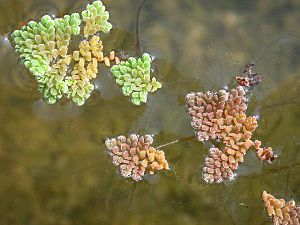Azolla pinnata facts for kids
Quick facts for kids Azolla pinnata |
|
|---|---|
 |
|
| Scientific classification | |
| Genus: |
Azolla
|
| Species: |
pinnata
|
Azolla pinnata is a tiny fern that floats on water. People call it by fun names like mosquitofern, feathered mosquitofern, or water velvet. This little plant grows naturally in many parts of Africa, Asia (like China, India, and Japan), and even some areas of Australia.
You can find Azolla pinnata floating on the surface of calm, slow-moving water. It doesn't like fast currents or big waves, as these can break it apart. This amazing plant can grow super fast! In less than two days, it can double its size under the right conditions.
Contents
What Does It Look Like?
Azolla pinnata is a very small fern. Its main part, called a frond, is shaped like a triangle and can be up to 2.5 centimeters long. This frond is made of many tiny, overlapping leaves, each only 1 or 2 millimeters long.
These leaves can be green, blue-green, or even dark red. They are covered in tiny hairs, which make the plant look and feel velvety. These special hairs help the plant float. They make the top of the leaf waterproof, so the plant stays on the surface even if it gets pushed underwater.
Sometimes, a whole pond or lake can be covered by a thick layer of these plants. They form a soft, velvety mat that can take up a lot of space. The plant also has thin, hair-like roots that hang down into the water.
A Special Friend Inside
Inside the leaves of Azolla pinnata, there's a tiny helper called a cyanobacterium named Anabaena azollae. This is a special partnership, like two friends helping each other out. The cyanobacterium can grab nitrogen from the air. Nitrogen is a very important nutrient that plants need to grow.
Because of this helpful friend, Azolla pinnata can grow well even in places where the soil or water doesn't have much nitrogen.
How It Grows and Spreads
Azolla pinnata can make more of itself in two ways. It can reproduce simply by breaking off small branches from the main plant. These broken pieces then grow into new plants. This is called vegetative reproduction.
It can also reproduce in a more traditional way, like many plants, by making spores. Tiny structures called sporocarps on the leaves release these spores, which can then grow into new ferns.
Where It Can Be a Problem
Sometimes, Azolla pinnata can cause issues. In New Zealand, for example, it's not native. It was brought there by people and has become an invasive weed. This means it grows so much that it crowds out other plants that naturally belong there, like a native relative called Azolla rubra.
When Azolla pinnata forms thick mats on the water, it can block sunlight and reduce the amount of oxygen in the water. This can be bad for fish and other water creatures. To control it, people sometimes use a small weevil insect called Stenopelmus rufinasus. This weevil helps manage a similar plant, Azolla filiculoides, and it also eats A. pinnata.
Amazing Uses of Azolla
Azolla pinnata is not just a pretty plant; it's very useful!
Helping Farmers
Rice farmers sometimes grow Azolla pinnata in their rice fields. Remember its special friend, the cyanobacterium, that fixes nitrogen? This means the Azolla plant acts like a natural fertilizer! It adds valuable nitrogen to the soil, which helps the rice plants grow stronger and healthier. Farmers can even grow Azolla in wet soil and then mix it into the ground, creating a rich, nitrogen-filled fertilizer for their crops.
Cleaning Up Water
This fern also has a special ability to help clean up polluted water. It can absorb certain heavy metals, like lead, from water that has been contaminated. This makes it useful in cleaning up the environment.
Food for Animals
Azolla pinnata is also quite nutritious! It's about 25-30% protein. Because of this, it can be added to chicken feed to give chickens extra nutrients.
Azolla and the Environment
Recent studies show that Azolla pinnata is very helpful in cleaning up environmental pollution. There are two main ways it can do this:
Adsorption Method
One way is called adsorption. For this, the Azolla fronds are dried and ground into a powder. This powder is then mixed with dirty wastewater. The pollutants, like certain dyes, stick to the surface of the Azolla powder. Scientists have used Azolla powder to clean water containing dyes like methyl violet, malachite green, and rhodamine B.
Phytoremediation Method
The second way is called phytoremediation. This is when living Azolla pinnata plants are floated on the surface of the wastewater. Azolla is great for this because it can handle a lot of pollution and can soak up heavy metals. It has been used to clean industrial wastewater that has heavy metals like zinc, lead, chromium, mercury, cadmium, copper, and arsenic. It can also help remove organic dyes.
Azolla pinnata can even help clean wastewater from poultry farms by removing nitrogen and phosphorus waste.

